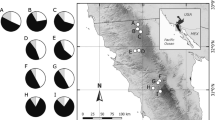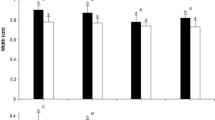Abstract
Selective pressures on seed size could vary among the different stages of plant life cycles, so no simple relation could explain a priori its evolution. Here, we determined the relationships between seed size and two fitness components—seed dispersal and survival from predation—in a bird-dispersed tree, Crataegus monogyna. We interpret these relationships in relation to the patterns of mass allocation to fruit and seed components. Selection patterns were assessed at two levels (1) selection pressures on the parent tree; comparing seed dispersal efficiency among individual plants and (2) selection pressures at the individual seed level; comparing seed size variation (i) before and after dispersal, and (ii) before and after postdispersal seed predation. Dispersal efficiency (percentage of seed crop dispersed) was positively correlated with fruit mass and fruit width. Differences in crop size did not offset this effect, and larger seeds were overrepresented in the seed rain relative to the seed pool before dispersal. However, the advantage of larger seeds during the dispersal stage was cancelled later by an opposite selection pressure exerted by seed predators. As a result, smaller seeds had a higher probability of surviving postdispersal seed predation, establishing an evolutionary conflict imposed by the need for dispersal and the danger of being predated. Birds and rodents preferentially selected highly profitable fruits and seeds in terms of the relative proportion of their components. Larger fruits had a higher pulp to seed proportion than smaller ones, and all seeds had the same proportion of coat relative to the embryo-plus-endosperm fraction. Hence, although predator pressures were stronger than disperser ones, larger seeds invested proportionally less in structural defense than in dispersal.



Similar content being viewed by others
References
Alcántara JM, Rey PJ (2003) Conflicting selection pressures on seed size: evolutionary ecology of fruit size in a bird-dispersed tree, Olea europaea. J Evol Biol 16:1168-1176
Alcántara JM, Rey PJ, Valera F, Sánchez-Lafuente AM (2000) Factors shaping the seedfall pattern of a bird-dispersed plant. Ecology 11:1937-1950
Biere A (1991) Parental effects in Lychnis flos-cuculi. I: seed size, germination and seedling performance in a controlled environment. J Evol Biol 3:447-465
Blate GM, Peart DR, Leighton M (1998) Post-dispersal predation on isolated seeds: comparative study of 40 tree species in a Southeast Asian rainforest. Oikos 82:522-538
Campbell DR (1991) Effects of floral traits on sequential components of fitness in Ipomopsis aggregata. Am Nat 137:713-737
Celis-Diez JL, Bustamante RO, Vásquez RA (2004) Assessing frequency-dependent seed size selection: a field experiment. Biol J Linn Soc 81:307-312
Debain S, Curt T, Lepart J (2003) Seed mass, seed dispersal capacity, and seedling performance in a Pinus sylvestris population. Écoscience 10:168-175
Edwards W (2005) Within- and between-species patterns of allocation to pulp and seed in vertebrate dispersed plants. Oikos 110:109-114
Endler JA (1986) Natural selection in the wild. Princeton University Press, Princeton, New Jersey, USA
Ganeshaiah KN, Uma Shaanker R (1991) Seed size optimization in a wind dispersed tree Butea monosperma: a trade-off between seedling establishment and pod dispersal efficiency. Oikos 60:3-6
García D, Zamora R, Gómez JM, Hódar J (1999) Bird rejection of unhealthy fruits reinforces the mutualism between juniper and its avian dispersers. Oikos 85:536-544
García D, Obeso JR, Martínez I (2005a) Rodent seed predation promotes differential seedling recruitment among bird-dispersed trees in temperate secondary forests. Oecologia 144:435-446
García D, Obeso JR, Martínez I (2005b) Spatial concordance between seed rain and seedling establishment in bird-dispersed trees: does scale matter? J Ecol 93:693-700
Gómez JM (2004) Bigger is not always better: conflicting selective pressures on seed size in Quercus ilex. Evolution 58:71-80
Guitián J, Fuentes M (1992) Reproductive biology of Crataegus monogyna in northwestern Spain. Acta Oecologica 13:3-11
Hedge SG, Uma Shaanker R, Ganeshaiah KN (1991) Evolution of seed size in the bird-dispersed tree Santalum album L.: a trade off between seedling establishment and dispersal efficiency. Evol Trends Plant 5:131-135
Herrera CM (1984) Adaptation to frugivory of mediterranean avian seed dispersers. Ecology 65:609-617
Herrera CM (1987) Vertebrate-dispersed plants of the Iberian Peninsula: a study of fruit characteristics. Ecol Monogr 57: 305-331
Herrera CM (1992) Interspecific variation in fruit shape: allometry, phylogeny, and adaptation to dispersal agents. Ecology 73:1832-1841
Herrera CM (2002) Seed dispersal by vertebrates. In: Herrera CM, Pellmyr O (eds) Plant–animal interactions: an evolutionary approach. Blackwell, Oxford, pp 185-208
Hulme PE (1998) Post-dispersal seed predation and seed bank persistence. Seed Sci Res 8:513-519
Janzen FJ, Stern H (1998) Logistic regression for empirical studies of multivariate selection. Evolution 52:1564-1571
Jordano P (1995) Frugivore-mediated selection on fruit and seed size: birds and St. Lucie’s cherry, Prunus mahaleb. Ecology 76:2627-2639
Kerley GIH, Erasmus T (1991) What do mice selected for in seeds? Oecologia 86:261-267
Kollmann J, Coomes DA, White SM (1998) Consistencies in post-dispersal seed predation of temperate fleshy-fruited species among seasons, years and sites. Funct Ecol 12:683-690
Legendre P, Legendre L (1998) Numerical ecology, 2nd edn. Elsevier, Amsterdam
Leishman MR, Wright IJ, Moles AT, Westoby M (2000) The evolutionary ecology of seed size. In: Fenner M (ed) Seeds, the ecology of regeneration in plant communities, 2nd edn. CABI Publishing, Wallingford, pp 31-57
Lynch M, Walsh B (1998) Genetics and analysis of quantitative traits. Sinauer Associates, Sunderland
Manzur MI, Courtney SP (1984) Influence of insect damage in fruits of hawthorn on bird foraging and seed dispersal. Oikos 43:265-270
Mazer SJ (1998) Rainforest plants protect their investments. Trends Ecol Evol 13:471-473
Mazer SJ, Wheelwright NT (1993) Fruit size and shape: allometry at different taxonomic levels in bird-dispersed plants. Evol Ecol 7:556-575
McCullagh P (1983) Quasi-likelihood functions. Ann Stat 11:59-67
Mojonnier L (1998) Natural selection on two seed-size traits in the common morning glory Ipomea purpurea (Convolvulaceae): patterns and evolutionary consequences. Am Nat 152:188-203
Moles AT, Westoby M (2004) Seedling survival and seed size: a synthesis of the literature. J Ecol 92:372-383
Moles AT, Warton DI, Westoby M (2003) Do small-seeded species have higher survival through seed predation than large-seeded species? Ecology 84:3148-3161
Obeso JR (1998) Patterns of variation in Ilex aquifolium fruit traits related to fruit consumption by birds and seed predation by rodents. Écoscience 5:463-469
Obeso JR, Herrera CM (1994) Inter- and intraspecific variation in fruit traits in co-occurring vertebrate-dispersed plants. Int J Plant Sci 155:382-387
Parciak W (2002) Environmental variation in seed number, size, and dispersal of a fleshy-fruited plant. Ecology 83:780-793
Rey PJ, Alcántara JM (2000) Recruitment dynamics of a fleshy-fruited plant (Olea europaea): connecting patterns of seed dispersal to seedling establishment. J Ecol 88:622-633
Rey PJ, Gutiérrez JE, Alcántara JM, Valera F (1997) Fruit size in wild olives: implications for avian seed dispersal. Funct Ecol 11:611-618
Sallabanks R (1992) Fruit fate, frugivory, and fruit characteristics: a study of the hawthorn, Crataegus monogyna (Rosaceae). Oecologia 91:296-304
Sallabanks R (1993) Hierarchical mechanisms of fruit selection by an avian frugivore. Ecology 74:1326-1336
SAS Institute (2004) SAS/STAT user’s guide, version 9.1. SAS Institute, Cary
Schupp EW (1995) Seed–seedling conflicts, habitat choice, and patterns of plant recruitment. Am J Bot 82:399-409
Smith CC (1970) The coevolution of pine squirrels (Tamiasciurus) and conifers. Ecol Monogr 40:349-371
Snow B, Snow D (1998) Birds and berries. T and AD Poyser, Waterhouses
Van der Wall S (1994) Removal of wind dispersed pine seeds by ground-foraging vertebrates. Oikos 69:125-132
Westoby M, Leishman M, Lord J (1996) Comparative ecology of seed size and dispersal. Philos Trans R Soc Lond B Biol Sci 351:1309-1318
Wheelwright NT (1993) Fruit size in a tropical tree species: variation, preference by birds, and heritability. Vegetatio 107/108:163-174
Acknowledgements
We thank Mariajo Bañuelos and Fernando González for useful comments on earlier versions of the manuscript. Fernando González also assisted us in statistical analyses. Two anonymous referees and the associate editor, Mark van Kleunen made numerous and valuable comments that greatly improved the manuscript. Angel Fidalgo helped during the fieldwork. We acknowledge a grant PFPU (MEC) to IM, a contract from Programme “Ramón y Cajal” (MCYT, Fondo Social Europeo) to DG, and the projects REN2003-0173 and CGL2004-2936 (MEC) to DG.
Author information
Authors and Affiliations
Corresponding author
Rights and permissions
About this article
Cite this article
Martínez, I., García, D. & Obeso, J.R. Allometric allocation in fruit and seed packaging conditions the conflict among selective pressures on seed size. Evol Ecol 21, 517–533 (2007). https://doi.org/10.1007/s10682-006-9132-x
Received:
Accepted:
Published:
Issue Date:
DOI: https://doi.org/10.1007/s10682-006-9132-x




